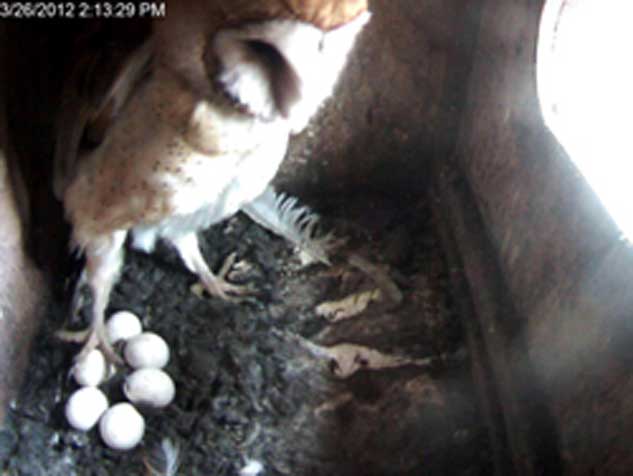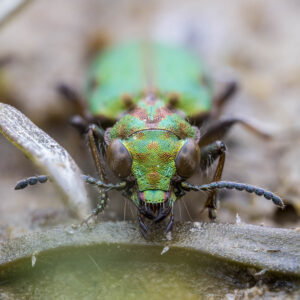“The box was placed there over twenty years ago and a pair has nested in it every season,” says Wendy Winsted, Recreation Coordinator for Sulphur Creek Nature Center (SCNC) in Hayward.
She’s talking about the barn owl nest box mounted 20 feet up in a blue-gum eucalyptus tree, set back a little way from the museum and wildlife rehabilitation hospital also on the grounds.
Last year, SCNC launched a 24 hour live-stream owl cam sponsored by Hayward Area Recreation and Park District, Castro Valley Rotary Club, Ojo Technology, and donations from the public. Now anyone in the world can get an intimate view of how barn owls (Tyto alba) mate and raise their young. “By the time last year’s clutch fledged we had over 101,000 hits from over 58 countries,” says Winsted.
“The female is in the box nearly all the time now,” says Nicole McGinnis, the center’s director of wildlife education. “The male will frequently come in and mate with her—we’re expecting to see eggs any day.”
The female will prepare the site by casting her pellets on the ground and breaking them up, providing an insulating layer between the ground and her eggs. The regurgitated pellets consist of undigested fur and bones, remains of animals she’s eaten. Once she starts laying she’ll produce one egg every other day until her clutch is complete, an average of 7 eggs. The eggs hatch in the order laid; this type of sequential laying ensures the survival of some chicks if food becomes scarce. By the time the last egg laid has hatched, there’s a vast size difference between the oldest and youngest of the clutch.
Each egg will hatch about 26 to 33 days after it’s laid. During this time the mother will stay with them to protect, turn, and incubate her nascent brood. The male will help with this part occasionally, but his chief job will be to bring her food every night.
“A family of seven barn owls eats the equivalent of 100 mice per night and a single adult barn owl eats around 1,000 rodents per year, making them very effective at rodent control,” says Winsted. “Around here it’s mostly gophers and rats.”
Organic farms and wineries in the Bay Area have started installing owl boxes instead of using rodenticides (rodent poison)—good news for the predator population.
“Rodenticide is such a huge problem for predators and ecosystem health,” says Rose Britton, animal care director at the wildlife center. Nearly all rodenticides work their way up the food chain, slowly poisoning animals that provide natural pest control. “Their immune system weakens so they succumb to diseases more easily. It affects their breeding, and it takes a lot longer for an owl population than a mouse population to bounce back after rodenticide has been introduced.”
Other organizations such as the Marin-based Hungry Owl Project (HOP) are also working to educate people about the effects of rodenticide. HOP’s mission is to reduce the need for poisons by building nest boxes and encouraging predators to stick around. “It’s not like you can attract owls by hanging a bird feeder filled with dead mice,” jokes Britton. “Barn owls don’t build nests, so providing a place for them to breed is the most important thing you can do to entice them to stay.”
A dramatic moment of barn owl rodent-control in action was caught on Sulphur Creek’s camera last year, when a three-week old owlet managed to eat a whole gopher in one bite:
“It’s heartstopping—watching the clip you just want to rush in and help somehow,” Winsted laughs. “For years we’ve had this owl box up but didn’t really know what was going on inside. Now we have an opportunity to really observe their behavior, from watching eggs hatch to seeing them grow up and set out on their own.”
To learn more about barn owls and other species that share space with us, visit Sulphur Creek and say hello to their resident animals. Admission is free, and they’re open to the public seven days a week.
And now, here’s a slide show of some camera stills from last year!
[slideshow]





